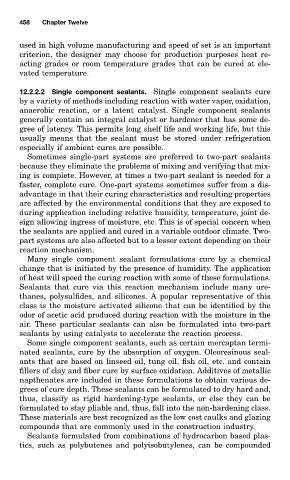Page 531 - Handbook of Adhesives and Sealants
P. 531
458 Chapter Twelve
used in high volume manufacturing and speed of set is an important
criterion, the designer may choose for production purposes heat re-
acting grades or room temperature grades that can be cured at ele-
vated temperature.
12.2.2.2 Single component sealants. Single component sealants cure
by a variety of methods including reaction with water vapor, oxidation,
anaerobic reaction, or a latent catalyst. Single component sealants
generally contain an integral catalyst or hardener that has some de-
gree of latency. This permits long shelf life and working life, but this
usually means that the sealant must be stored under refrigeration
especially if ambient cures are possible.
Sometimes single-part systems are preferred to two-part sealants
because they eliminate the problems of mixing and verifying that mix-
ing is complete. However, at times a two-part sealant is needed for a
faster, complete cure. One-part systems sometimes suffer from a dis-
advantage in that their curing characteristics and resulting properties
are affected by the environmental conditions that they are exposed to
during application including relative humidity, temperature, joint de-
sign allowing ingress of moisture, etc. This is of special concern when
the sealants are applied and cured in a variable outdoor climate. Two-
part systems are also affected but to a lesser extent depending on their
reaction mechanism.
Many single component sealant formulations cure by a chemical
change that is initiated by the presence of humidity. The application
of heat will speed the curing reaction with some of these formulations.
Sealants that cure via this reaction mechanism include many ure-
thanes, polysulfides, and silicones. A popular representative of this
class is the moisture activated silicone that can be identified by the
odor of acetic acid produced during reaction with the moisture in the
air. These particular sealants can also be formulated into two-part
sealants by using catalysts to accelerate the reaction process.
Some single component sealants, such as certain mercaptan termi-
nated sealants, cure by the absorption of oxygen. Oleoresinous seal-
ants that are based on linseed oil, tung oil, fish oil, etc. and contain
fillers of clay and fiber cure by surface oxidation. Additives of metallic
napthenates are included in these formulations to obtain various de-
grees of cure depth. These sealants can be formulated to dry hard and,
thus, classify as rigid hardening-type sealants, or else they can be
formulated to stay pliable and, thus, fall into the non-hardening class.
These materials are best recognized as the low cost caulks and glazing
compounds that are commonly used in the construction industry.
Sealants formulated from combinations of hydrocarbon based plas-
tics, such as polybutenes and polyisobutylenes, can be compounded

